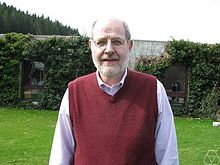| Ronald George Douglas | |
|---|---|
 | |
| Born | (1938-12-10)December 10, 1938 Osgood, Indiana, USA |
| Died | February 27, 2018(2018-02-27) (aged 79) College Station, Texas, USA |
| Nationality | American |
| Occupation | Mathematician |
| Known for | Douglas-Arveson conjecture Douglas' lemma |
| Academic background | |
| Education | Illinois Institute of Technology Louisiana State University |
| Doctoral advisor | Pasquale Porcelli |
| Academic work | |
| Institutions | University of Michigan Stony Brook University Texas A&M University |
| Doctoral students | Paul Muhly Guoliang Yu Gadadhar Misra |
Ronald George Douglas (December 10, 1938 – February 27, 2018) was an American mathematician, best known for his work on operator theory and operator algebras.
Education and career
Douglas was born in Osgood, Indiana. He was an undergraduate at the Illinois Institute of Technology, and received his Ph.D. in 1962 from Louisiana State University as a student of Pasquale Porcelli. He was at the University of Michigan until 1969, when he moved to the State University of New York at Stony Brook. Beginning in 1986 he moved into university administration, eventually becoming Vice Provost at Stony Brook in 1990, and Provost at Texas A&M University from 1996 until 2002. At the time of his death, he was Distinguished Professor in the Department of Mathematics at Texas A&M. He is survived by three children, including Michael R. Douglas, a noted string theorist.
Research
Among his best-known contributions to science is a 1977 paper with Lawrence G. Brown and Peter A. Fillmore (BDF theory), which introduced techniques from algebraic topology into the theory of operator algebras. This work was an important precursor to noncommutative geometry as later developed by Alain Connes among others. In addition to BDF theory, two other influential theories bear his names: Douglas algebra and Cowen-Douglas operators. In recent decades, he was a prominent advocator of multivariable operator theory. His coauthored book with Vern Paulsen "Hilbert modules over function algebras" introduced an analytic framework for studying commuting operator tuples. Douglas-Arveson conjecture is a well-known unsolved problem in this field.
Douglas directed 23 Ph.D students, some of whom became renowned mathematicians, and his book Banach Algebra Techniques in Operator Theory in the series Graduate Texts in Mathematics is one of the classics in operator theory.
Honors and awards
In 2012, he became a fellow of the American Mathematical Society.
See also
References
- Home, Bryant Funeral. "Tribute for Ronald George Douglas | Bryant Funeral Home". Tribute for Ronald George Douglas | Bryant Funeral Home. Retrieved 2022-10-09.
- "Texas A&M Mourns Loss of Distinguished Mathematician and Former Provost Ron Douglas". College of Science Communications, Texas A&M. 2 March 2018. Retrieved 2018-03-08.
- List of Fellows of the American Mathematical Society. Retrieved 2012-11-10.
- Brown, L. G.; Douglas, R. G.; Fillmore, P. A., "Extensions of C*-algebras and K-homology", Annals of Mathematics (2) 105 (1977), no. 2, 265–324. MR0458196
External links
This article about an American mathematician is a stub. You can help Misplaced Pages by expanding it. |
- 1938 births
- 2018 deaths
- 20th-century American mathematicians
- 21st-century American mathematicians
- Texas A&M University faculty
- University of Michigan faculty
- Stony Brook University faculty
- Louisiana State University alumni
- Fellows of the American Mathematical Society
- Illinois Institute of Technology alumni
- People from Ripley County, Indiana
- Operator theorists
- American mathematician stubs